Whether you’re firing up the grill for a summer barbecue or craving a cozy weeknight dinner, nothing beats a perfectly marinated pork steak. These 24 flavor-packed recipes will transform your pork into tender, juicy masterpieces that’ll have everyone asking for seconds. Get ready to discover marinades that range from sweet and tangy to savory and spicy—your next favorite meal is waiting in this list!
Soy Honey Garlic Pork Marinade

Perhaps it’s the way golden hour light falls across the kitchen counter, but there’s something deeply comforting about preparing a marinade that promises both simplicity and depth. This soy honey garlic blend feels like a quiet secret, one that transforms the humble pork cutlet into something memorably tender and complex, a dish that seems to understand the need for both ease and elegance on a weary weekday.
Ingredients
- 1 ½ pounds heritage-breed pork tenderloin, trimmed of silver skin
- ½ cup naturally fermented soy sauce
- ¼ cup raw wildflower honey
- 4 cloves heirloom garlic, microplaned into a fine paste
- 2 tablespoons cold-pressed sesame oil
- 1 tablespoon freshly grated ginger root
- 1 teaspoon freshly cracked tellicherry black pepper
Instructions
- In a non-reactive glass bowl, combine the naturally fermented soy sauce, raw wildflower honey, microplaned heirloom garlic paste, cold-pressed sesame oil, freshly grated ginger root, and freshly cracked tellicherry black pepper, whisking vigorously for 45 seconds until the honey fully dissolves and the emulsion appears glossy.
- Pat the heritage-breed pork tenderloin completely dry with unbleached parchment paper, ensuring no moisture remains on the surface to prevent steaming during searing.
- Submerge the pork tenderloin fully in the marinade, massaging the mixture into the meat’s surface with your fingertips to ensure even penetration.
- Cover the bowl tightly with beeswax wrap and refrigerate for exactly 8 hours—this precise timing allows the enzymatic action of the ginger to tenderize without breaking down the protein structure excessively.
- Remove the marinated pork from the refrigerator 30 minutes before cooking to bring it to room temperature, which promotes even cooking from edge to center.
- Preheat a cast-iron skillet over medium-high heat until a drop of water sizzles and evaporates within 2 seconds.
- Sear the pork tenderloin for 3 minutes per side until a deep mahogany crust forms, resisting the urge to move it during this time to develop proper Maillard reaction.
- Transfer the seared pork to a wire rack set over a baking sheet and finish in a 375°F oven for 12-14 minutes until the internal temperature reaches 145°F when measured with an instant-read thermometer inserted into the thickest part.
- Rest the cooked pork on a clean cutting board for exactly 8 minutes to allow juices to redistribute evenly throughout the muscle fibers.
- Slice the pork against the grain into ½-inch medallions using a sharp chef’s knife, angling the blade slightly to create wider, more visually appealing pieces.
What emerges is pork with a lacquered, caramelized exterior that gives way to impossibly juicy flesh beneath—the garlic and ginger notes bloom warmly while the honey provides just enough sweetness to balance the soy’s umami depth. Consider serving these glistening slices over jasmine rice with a scattering of toasted sesame seeds, or thinly sliced and tucked into warm tortillas with quick-pickled vegetables for a vibrant taco night variation.
Pineapple Teriyaki Pork Steak Marinade

Years of cooking have taught me that the most memorable meals often come from simple ingredients transformed by time and attention. This pineapple teriyaki marinade creates pork steaks with a beautiful balance of sweet and savory, the kind of dish that makes an ordinary Tuesday feel special. Letting the flavors meld slowly yields results worth waiting for.
Ingredients
– 2 pasture-raised pork shoulder steaks (1-inch thick)
– 1 cup fresh pineapple juice
– ¼ cup naturally fermented soy sauce
– 2 tablespoons raw honey
– 1 tablespoon toasted sesame oil
– 2 cloves garlic, microplaned
– 1 teaspoon freshly grated ginger root
– ½ teaspoon freshly cracked black pepper
Instructions
1. Combine 1 cup fresh pineapple juice, ¼ cup naturally fermented soy sauce, 2 tablespoons raw honey, 1 tablespoon toasted sesame oil, 2 cloves microplaned garlic, 1 teaspoon freshly grated ginger root, and ½ teaspoon freshly cracked black pepper in a glass bowl.
2. Whisk the marinade ingredients vigorously for 30 seconds until the honey fully dissolves and the emulsion appears uniform.
3. Place 2 pasture-raised pork shoulder steaks in a shallow ceramic dish, ensuring they lie flat without overlapping.
4. Pour the marinade over the pork steaks, coating both sides completely using tongs.
5. Cover the dish with plastic wrap pressed directly against the meat surface to eliminate air pockets.
6. Refrigerate the marinating pork for exactly 8 hours, flipping the steaks once at the 4-hour mark using clean tongs.
7. Remove the pork from the refrigerator 30 minutes before cooking to reach room temperature for even cooking.
8. Preheat a cast-iron skillet over medium-high heat until water droplets sizzle and evaporate within 2 seconds.
9. Remove the pork steaks from the marinade, allowing excess liquid to drip off while reserving ¼ cup marinade for basting.
10. Sear the pork steaks for 4 minutes without moving to develop a deep caramelized crust.
11. Flip the steaks using tongs and cook for another 3 minutes.
12. Reduce heat to medium and brush the reserved marinade over the pork steaks using a silicone basting brush.
13. Continue cooking for 2 additional minutes, flipping once more, until the internal temperature reaches 145°F on an instant-read thermometer.
14. Transfer the pork steaks to a clean cutting board and rest undisturbed for 5 minutes to redistribute juices.
15. Slice the pork against the grain into ½-inch thick strips.
Layers of caramelized sweetness give way to tender, juicy pork that practically melts with each bite. The pineapple’s natural enzymes create an exceptionally delicate texture while the fermented soy sauce provides umami depth. Serve these sliced over jasmine rice with quick-pickled vegetables for contrasting crunch, or tuck into warm tortillas with fresh cilantro for a tropical twist on taco night.
Spicy Cajun Pork Marinade
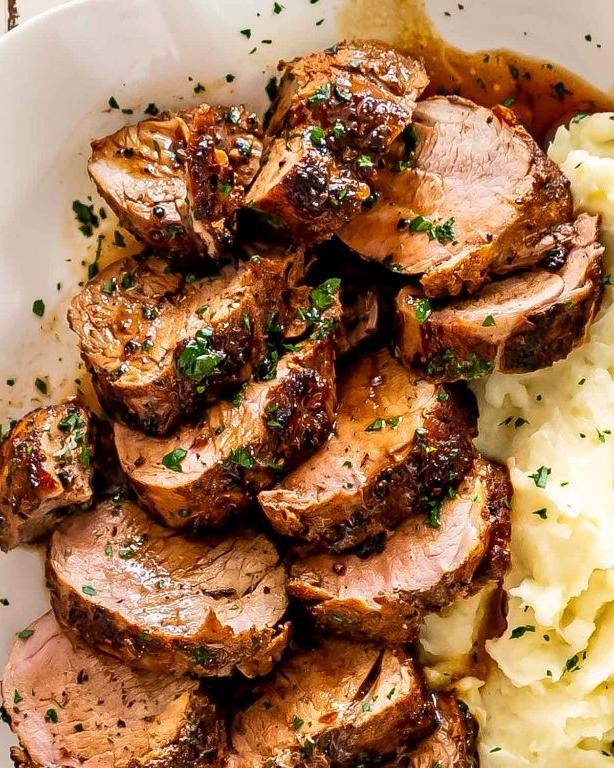
Unfolding the layers of this marinade feels like uncovering an old family secret, one that transforms simple pork into something deeply comforting and complex. There’s something almost meditative about watching the spices bloom in oil, releasing their earthy aromas while preparing for the slow infusion ahead. This particular blend carries the warmth of Southern kitchens and the gentle heat that lingers just long enough to be memorable.
Ingredients
– 2 pounds heritage-breed pork shoulder, cut into 2-inch cubes
– ¼ cup extra virgin olive oil
– 3 tablespoons smoked paprika
– 2 tablespoons granulated garlic
– 1 tablespoon dried thyme
– 2 teaspoons cayenne pepper
– 1 teaspoon freshly cracked black pepper
– 1 tablespoon coarse sea salt
– 2 tablespoons raw honey
– ¼ cup apple cider vinegar
Instructions
1. Combine ¼ cup extra virgin olive oil, 3 tablespoons smoked paprika, 2 tablespoons granulated garlic, 1 tablespoon dried thyme, 2 teaspoons cayenne pepper, and 1 teaspoon freshly cracked black pepper in a small saucepan over medium-low heat.
2. Warm the spice mixture for 3-4 minutes until fragrant, swirling the pan constantly to prevent burning.
3. Remove the saucepan from heat and whisk in 1 tablespoon coarse sea salt, 2 tablespoons raw honey, and ¼ cup apple cider vinegar until fully emulsified.
4. Pat 2 pounds heritage-breed pork shoulder cubes completely dry with paper towels to ensure proper marinade adhesion.
5. Place the dried pork cubes in a glass or ceramic bowl and pour the cooled marinade over them, coating each piece thoroughly.
6. Cover the bowl with plastic wrap and refrigerate for exactly 8 hours to allow the flavors to penetrate deeply into the meat fibers.
7. Remove the marinated pork from refrigerator 30 minutes before cooking to bring it to room temperature for even cooking.
8. Preheat grill to 425°F or heat a cast-iron skillet over medium-high heat until a drop of water sizzles immediately.
9. Cook the pork cubes for 6-7 minutes per side until they develop a dark, caramelized crust and reach an internal temperature of 145°F.
10. Transfer the cooked pork to a clean plate and let rest for 5 minutes before serving to allow juices to redistribute.
Zestfully caramelized edges give way to remarkably tender interiors that practically melt against the tongue. The initial smokiness unfolds into subtle heat that builds gradually rather than overwhelming the palate. Consider serving these pork cubes over creamy stone-ground grits or tucked into warm corn tortillas with crisp cabbage slaw for contrasting textures.
Lemon Herb Dijon Marinade for Pork Steaks

Years of cooking have taught me that the simplest marinades often hold the most profound flavors, and this lemon herb Dijon blend for pork steaks is no exception—it’s a quiet, thoughtful preparation that transforms an ordinary cut into something tender and bright, perfect for a slow evening meal.
Ingredients
– 1/2 cup extra-virgin olive oil
– 1/4 cup freshly squeezed lemon juice
– 3 tablespoons Dijon mustard
– 2 tablespoons minced fresh rosemary
– 1 tablespoon minced fresh thyme
– 4 garlic cloves, finely minced
– 1 teaspoon fine sea salt
– 1/2 teaspoon freshly cracked black pepper
– 4 bone-in pork steaks, approximately 1-inch thick
Instructions
1. In a medium glass bowl, whisk together the extra-virgin olive oil and freshly squeezed lemon juice until emulsified.
2. Add the Dijon mustard, minced fresh rosemary, minced fresh thyme, finely minced garlic cloves, fine sea salt, and freshly cracked black pepper to the bowl, whisking vigorously to form a homogeneous marinade.
3. Place the bone-in pork steaks in a large, resealable plastic bag or shallow glass dish, ensuring they lie in a single layer.
4. Pour the marinade over the pork steaks, coating each piece thoroughly on all sides.
5. Seal the bag or cover the dish with plastic wrap, then refrigerate for at least 4 hours or up to 12 hours for optimal flavor penetration.
6. Preheat a grill or grill pan to medium-high heat, approximately 400°F, and lightly oil the grates to prevent sticking.
7. Remove the pork steaks from the marinade, allowing any excess to drip off, and discard the used marinade.
8. Grill the pork steaks for 6-7 minutes per side, or until the internal temperature reaches 145°F on an instant-read thermometer.
9. Transfer the grilled pork steaks to a clean cutting board and let them rest, undisturbed, for 5 minutes to redistribute juices.
10. Slice the pork steaks against the grain into 1/2-inch thick portions before serving.
Ultimately, the marinade yields pork that’s remarkably tender with a subtle crust, while the lemon and herbs cut through the richness for a balanced, aromatic finish. Consider serving it alongside roasted fingerling potatoes or a simple arugula salad to let the flavors shine without distraction.
Maple Balsamic Glazed Pork Marinade
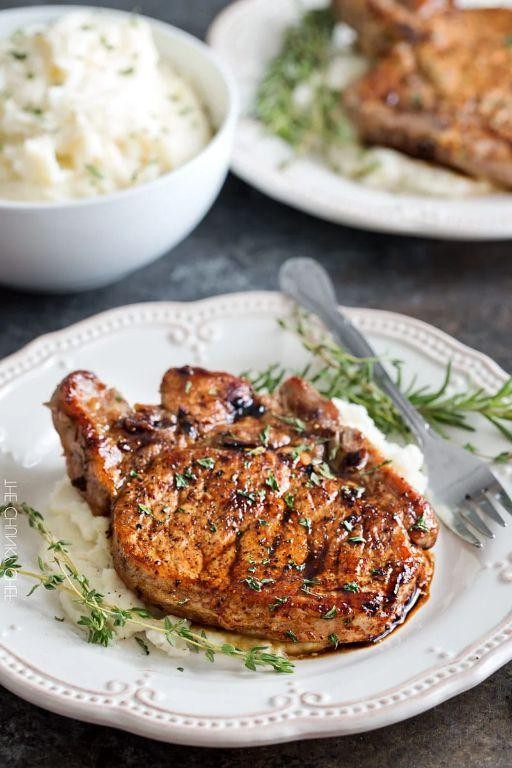
Zestfully remembering how the autumn light catches the maple trees, I find myself returning to this marinade year after year, its sweet-tart balance capturing the very essence of the season in a way that feels both comforting and celebratory. There’s something deeply satisfying about preparing it slowly, measuring each ingredient with care, as if the ritual itself is part of the nourishment.
Ingredients
- 1/2 cup pure maple syrup, grade A dark amber
- 1/4 cup aged balsamic vinegar
- 3 tablespoons extra virgin olive oil
- 2 cloves fresh garlic, finely minced
- 1 tablespoon Dijon mustard
- 1 teaspoon freshly cracked black pepper
- 1/2 teaspoon fine sea salt
- 1 1/2 pounds pasture-raised pork tenderloin
Instructions
- Combine 1/2 cup pure maple syrup, 1/4 cup aged balsamic vinegar, 3 tablespoons extra virgin olive oil, 2 cloves finely minced fresh garlic, 1 tablespoon Dijon mustard, 1 teaspoon freshly cracked black pepper, and 1/2 teaspoon fine sea salt in a medium glass bowl.
- Whisk the marinade ingredients vigorously for 60 seconds until fully emulsified and slightly thickened.
- Place 1 1/2 pounds pasture-raised pork tenderloin in a gallon-sized resealable plastic bag, pouring the marinade over the meat.
- Press out excess air from the bag before sealing to ensure maximum contact between marinade and pork.
- Refrigerate the marinating pork for exactly 4 hours, turning the bag once halfway through for even flavor distribution.
- Preheat oven to 400°F and position rack in the center of the oven.
- Remove pork from marinade, letting excess liquid drip back into the bag, then transfer pork to a wire rack set over a rimmed baking sheet.
- Reserve the used marinade in a small saucepan for later use.
- Roast pork at 400°F for 22-25 minutes until internal temperature reaches 145°F when measured with an instant-read thermometer inserted into the thickest part.
- While pork roasts, bring reserved marinade to a boil over medium-high heat, then reduce to a simmer for 8 minutes until reduced by half and slightly thickened.
- Brush the reduced glaze over pork during the final 5 minutes of roasting to create a caramelized crust.
- Transfer pork to a cutting board and rest for 8 minutes before slicing against the grain into 1/2-inch medallions.
Heirloom cutting board ready, the sliced pork reveals its perfect blush-pink interior, each medallion glistening with that deep amber glaze. The exterior gives way with satisfying resistance to reveal remarkably tender meat beneath, while the maple’s woody sweetness plays beautifully against the balsamic’s sharp acidity. Consider serving these slices fanned over creamy polenta or alongside roasted root vegetables, where the glaze can mingle with their earthy notes.
Sweet and Sour Asian Pork Marinade
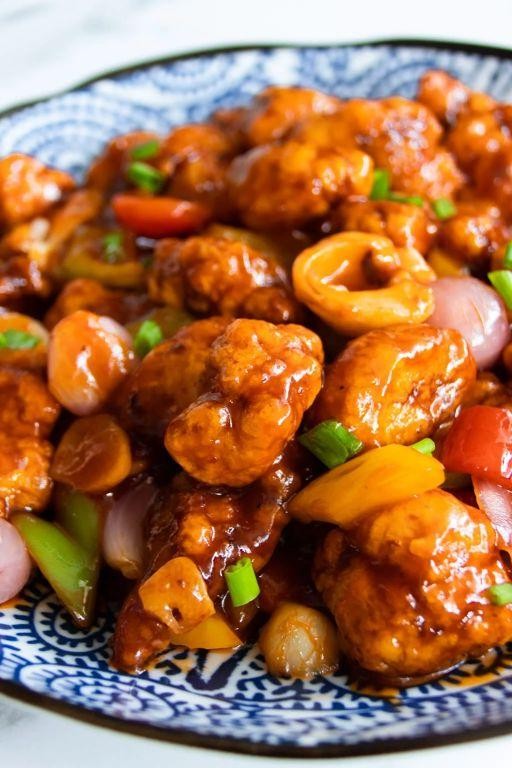
Perhaps there are moments when the simplest combinations reveal the most profound truths about balance—this marinade, with its gentle dance between sweet and sour, feels like one of those quiet revelations.
Ingredients
- 1/2 cup naturally fermented soy sauce
- 1/4 cup unrefined cane sugar
- 3 tablespoons rice vinegar
- 2 tablespoons toasted sesame oil
- 4 cloves garlic, microplaned
- 1 tablespoon freshly grated ginger root
- 1/2 teaspoon freshly cracked black pepper
- 1.5 pounds heritage-breed pork shoulder, cut into 1-inch cubes
Instructions
- In a medium glass bowl, whisk together the naturally fermented soy sauce and unrefined cane sugar until the sugar fully dissolves, about 45 seconds of vigorous stirring.
- Add the rice vinegar and toasted sesame oil to the bowl, whisking continuously to emulsify the liquids into a cohesive base.
- Incorporate the microplaned garlic and freshly grated ginger root, stirring gently to distribute the aromatics evenly throughout the mixture.
- Season the marinade with freshly cracked black pepper, then submerge the heritage-breed pork shoulder cubes completely in the liquid.
- Cover the bowl tightly with plastic wrap and refrigerate for exactly 8 hours to allow the pork fibers to tenderize and absorb the flavors.
- Preheat a cast-iron skillet over medium-high heat until a drop of water sizzles and evaporates within 2 seconds.
- Remove the pork from the marinade using tongs, letting excess liquid drip back into the bowl before placing the cubes in the hot skillet.
- Sear the pork for 3 minutes per side until a deep caramelized crust forms, resisting the urge to move the pieces during this initial searing phase.
- Reduce the heat to medium-low and pour the reserved marinade into the skillet, scraping any fond from the bottom with a wooden spatula.
- Simmer the pork in the marinade for 12 minutes, or until the internal temperature reaches 145°F on an instant-read thermometer inserted into the thickest cube.
You’ll find the pork develops an almost candied exterior that gives way to remarkably tender flesh beneath, the sharp tang of vinegar cutting through the richness in a way that begs to be served over jasmine rice with quick-pickled vegetables scattered across the top.
Smoky Chipotle BBQ Pork Steak Marinade

Holding this bowl of marinade, I’m reminded how the simplest rituals can transform an ordinary Tuesday into something quietly special, the smoky aroma already promising comfort before the cooking even begins.
Ingredients
– 2 pasture-raised pork shoulder steaks (1-inch thick)
– ¼ cup extra-virgin olive oil
– 3 tablespoons chipotle peppers in adobo sauce, finely minced
– 2 tablespoons raw honey
– 1 tablespoon smoked paprika
– 2 teaspoons Worcestershire sauce
– 1 teaspoon garlic powder
– ½ teaspoon fine sea salt
– ¼ teaspoon freshly cracked black pepper
Instructions
1. Pat the pasture-raised pork shoulder steaks completely dry using paper towels to ensure proper browning.
2. Whisk together ¼ cup extra-virgin olive oil, 3 tablespoons minced chipotle peppers in adobo sauce, 2 tablespoons raw honey, 1 tablespoon smoked paprika, 2 teaspoons Worcestershire sauce, 1 teaspoon garlic powder, ½ teaspoon fine sea salt, and ¼ teaspoon freshly cracked black pepper in a glass bowl until fully emulsified.
3. Place the dried pork steaks in a resealable plastic bag and pour the marinade over them, ensuring complete coverage.
4. Press out excess air before sealing the bag, then massage the marinade into the meat through the plastic for 30 seconds to distribute flavors evenly.
5. Refrigerate the marinating pork for exactly 4 hours—this precise timing allows the acid to tenderize without breaking down the meat’s texture.
6. Remove the marinated pork from refrigeration 30 minutes before cooking to bring it to room temperature for even cooking.
7. Preheat a cast-iron skillet over medium-high heat until a drop of water sizzles and evaporates immediately.
8. Carefully place the marinated pork steaks in the dry, hot skillet, reserving excess marinade.
9. Sear for 4 minutes without moving to develop a deep caramelized crust.
10. Flip the steaks using tongs and cook for another 4 minutes until the internal temperature reaches 145°F on an instant-read thermometer.
11. Transfer the cooked pork steaks to a clean cutting board and let rest for 5 minutes to allow juices to redistribute.
12. Slice against the grain into ½-inch thick strips to maximize tenderness. Caramelized edges give way to remarkably juicy interiors that carry the chipotle’s gentle heat through each bite. Consider serving these sliced strips over creamy polenta where the smoky sauce mingles beautifully with the corn’s sweetness, or tuck them into warm tortillas with crisp cabbage slaw for contrasting textures.
Classic Italian Herb and Olive Oil Marinade
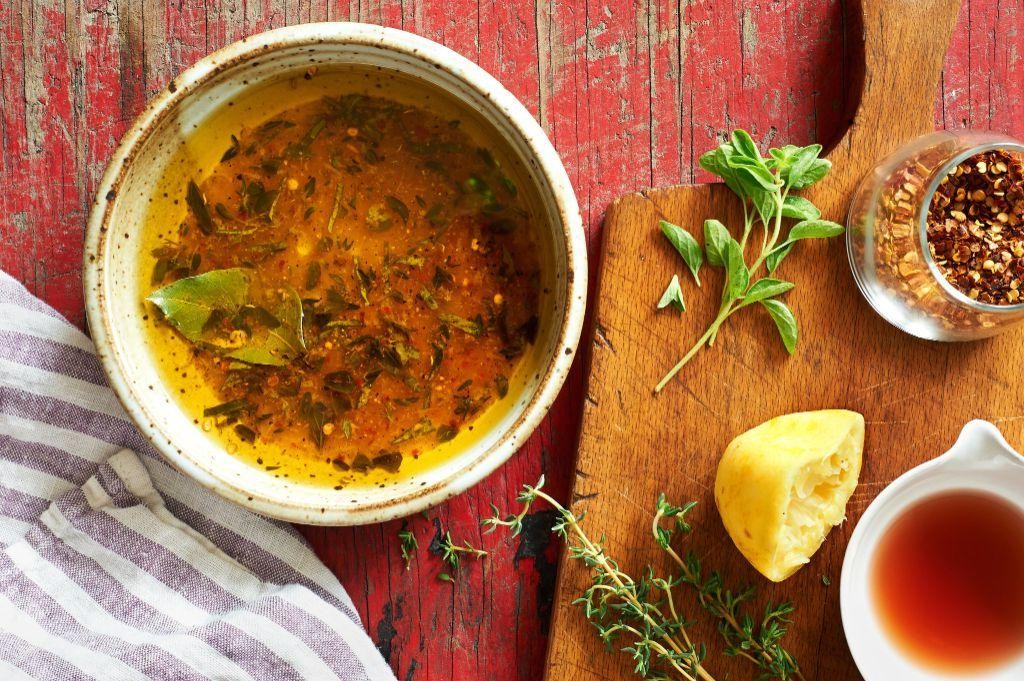
Reflecting on this quiet evening, I find myself returning to the simple alchemy of this marinade—how these few ingredients transform ordinary meals into something quietly extraordinary, connecting us to generations of Mediterranean kitchens.
Ingredients
- 1 cup extra-virgin olive oil, cold-pressed
- ¼ cup freshly squeezed lemon juice
- 3 tablespoons finely chopped fresh oregano leaves
- 2 tablespoons minced fresh rosemary needles
- 4 cloves garlic, microplaned to a fine paste
- 1 teaspoon coarse sea salt
- ½ teaspoon freshly cracked black peppercorns
- 1 teaspoon raw wildflower honey
Instructions
- Measure 1 cup cold-pressed extra-virgin olive oil into a medium glass mixing bowl.
- Whisk in ¼ cup freshly squeezed lemon juice until the mixture appears slightly emulsified, about 45 seconds of vigorous stirring.
- Add 3 tablespoons finely chopped fresh oregano leaves and 2 tablespoons minced fresh rosemary needles to the oil mixture.
- Incorporate 4 cloves of microplaned garlic paste, stirring gently to distribute evenly throughout the liquid.
- Sprinkle 1 teaspoon coarse sea salt and ½ teaspoon freshly cracked black peppercorns into the marinade base.
- Drizzle 1 teaspoon raw wildflower honey into the mixture, whisking continuously until fully dissolved.
- Transfer the completed marinade to an airtight glass container and refrigerate for exactly 24 hours to allow the herb flavors to fully infuse the oil.
- Remove the marinated mixture from refrigeration 30 minutes before use to bring it to room temperature, approximately 68°F.
- Stir the marinade thoroughly to recombine any separated ingredients before applying to your protein or vegetables.
Perfect for drizzling over grilled vegetables or as a base for roasted chicken, this marinade creates a beautifully herbaceous crust when seared at high heat. The cold-pressed oil carries the garlic and rosemary deep into the food’s fibers, while the honey provides just enough caramelization to balance the lemon’s bright acidity. Try brushing it over thick-cut heirloom tomato slices before a quick broil—the way the herbs cling to the juicy flesh creates a wonderful contrast of textures.
Zesty Lime and Cilantro Marinade

Floating through the evening kitchen, I find myself drawn to the bright, clean notes of citrus and herbs—a simple marinade that transforms the ordinary into something quietly extraordinary. This zesty lime and cilantro blend has become my go-to for infusing everyday proteins with vibrant freshness, a recipe born from summer evenings and the desire for food that feels both nourishing and celebratory.
Ingredients
– ½ cup freshly squeezed lime juice
– ¼ cup extra-virgin olive oil
– ¼ cup finely chopped fresh cilantro leaves
– 2 tablespoons raw honey
– 4 garlic cloves, microplaned
– 1 teaspoon Diamond Crystal kosher salt
– ½ teaspoon freshly cracked black pepper
Instructions
1. Combine ½ cup freshly squeezed lime juice, ¼ cup extra-virgin olive oil, and 2 tablespoons raw honey in a medium glass bowl, whisking vigorously for 45 seconds until fully emulsified.
2. Microplane 4 garlic cloves directly into the mixture to capture their essential oils, whisking to incorporate.
3. Finely chop ¼ cup fresh cilantro leaves, using only the tender leaves and upper stems for optimal flavor, then stir into the marinade.
4. Season with 1 teaspoon Diamond Crystal kosher salt and ½ teaspoon freshly cracked black pepper, whisking until all ingredients are fully integrated.
5. Transfer the marinade to an airtight glass container and refrigerate for exactly 2 hours to allow flavors to meld properly.
6. Remove from refrigerator and whisk briefly before use, noting the marinade should appear slightly thickened and uniformly green.
Sun-kissed and herbaceous, this marinade creates a beautifully caramelized crust when grilled, while keeping chicken or shrimp remarkably moist inside. The lime’s acidity softens into a mellow brightness that pairs wonderfully with avocado slices or over cilantro-lime rice, making even weeknight dinners feel like a small, intentional celebration.
Savory Mustard and Brown Sugar Pork Marinade

Sometimes, the simplest combinations reveal themselves in quiet moments, when the sharp tang of mustard meets the deep caramel notes of brown sugar, creating something unexpectedly profound for an ordinary pork dish. This marinade transforms the humble cut into something tender and complex, with flavors that linger long after the meal is finished. It’s a reminder that patience in preparation often yields the most comforting rewards.
Ingredients
– 1 ½ pounds pasture-raised pork loin, trimmed of excess silver skin
– ½ cup Dijon mustard
– ¼ cup dark brown sugar, firmly packed
– 3 tablespoons extra-virgin olive oil
– 2 tablespoons apple cider vinegar
– 4 cloves garlic, finely minced
– 1 teaspoon smoked paprika
– ½ teaspoon freshly cracked black pepper
– ½ teaspoon fine sea salt
Instructions
1. In a medium glass or ceramic bowl, whisk together the Dijon mustard, dark brown sugar, extra-virgin olive oil, and apple cider vinegar until fully emulsified and no sugar granules remain visible.
2. Stir in the finely minced garlic, smoked paprika, freshly cracked black pepper, and fine sea salt until the marinade is uniformly combined.
3. Place the trimmed pasture-raised pork loin into a large resealable plastic bag or shallow non-reactive dish, ensuring the pork lies flat.
4. Pour the marinade over the pork, coating all surfaces thoroughly by turning the pork several times in the bag or basting it in the dish.
5. Seal the bag or cover the dish tightly with plastic wrap, then refrigerate for at least 4 hours or up to 12 hours for optimal flavor penetration—marinating overnight deepens the savory-sweet balance.
6. Preheat your oven to 375°F and position a rack in the center of the oven for even heat distribution.
7. Remove the pork from the marinade, allowing any excess to drip off, and transfer it to a roasting pan fitted with a wire rack to promote air circulation and prevent steaming.
8. Discard the used marinade to avoid cross-contamination from raw pork juices.
9. Roast the pork for 25–30 minutes, or until an instant-read thermometer inserted into the thickest part registers 145°F for a juicy, slightly pink center.
10. Transfer the pork to a cutting board and let it rest for 8–10 minutes; this allows the juices to redistribute, ensuring each slice remains moist.
11. Slice the pork against the grain into ½-inch thick portions to maximize tenderness.Velvety and richly glazed, the pork emerges with a caramelized crust that gives way to succulent, pink-tinged meat beneath. The mustard provides a subtle sharpness that cuts through the sweetness, while the smoked paprika lends a whisper of wood-fired depth. Serve it sliced over creamy polenta or alongside roasted root vegetables to highlight its autumnal warmth.
Ginger Sesame Soy Marinade for Pork Steaks

Lately, I’ve found myself returning to this marinade again and again, its familiar aromas filling my kitchen with the comforting scent of toasted sesame and fresh ginger. There’s something deeply soothing about the way these simple ingredients transform ordinary pork steaks into something extraordinary. Each time I prepare it, the process feels like a quiet meditation, a gentle unfolding of flavors that never fails to comfort.
Ingredients
– 4 bone-in pork shoulder steaks, 1-inch thick
– ½ cup naturally brewed soy sauce
– ¼ cup toasted sesame oil
– 3 tablespoons raw honey
– 2 tablespoons freshly grated ginger root
– 4 garlic cloves, microplaned
– 2 teaspoons toasted white sesame seeds
– ½ teaspoon freshly cracked black pepper
Instructions
1. Combine ½ cup naturally brewed soy sauce, ¼ cup toasted sesame oil, 3 tablespoons raw honey, 2 tablespoons freshly grated ginger root, 4 microplaned garlic cloves, 2 teaspoons toasted white sesame seeds, and ½ teaspoon freshly cracked black pepper in a glass mixing bowl.
2. Whisk the marinade ingredients vigorously for 60 seconds until the honey fully dissolves and the emulsion appears glossy and uniform.
3. Place 4 bone-in pork shoulder steaks in a single layer within a glass baking dish, ensuring they do not overlap.
4. Pour the marinade evenly over the pork steaks, using a silicone brush to coat both surfaces completely.
5. Cover the baking dish with plastic wrap and refrigerate for exactly 8 hours, flipping the steaks once at the 4-hour mark for even penetration.
6. Remove the marinated pork steaks from the refrigerator 30 minutes before cooking to reach room temperature.
7. Preheat a cast-iron skillet over medium-high heat until a drop of water sizzles and evaporates immediately upon contact.
8. Place the pork steaks in the dry, hot skillet, reserving the remaining marinade for later use.
9. Sear the steaks for 4 minutes without moving them to develop a deep golden-brown crust.
10. Flip the steaks using kitchen tongs and cook for another 4 minutes on the second side.
11. Reduce the heat to medium and continue cooking for 6-8 minutes, until the internal temperature reaches 145°F when measured with an instant-read thermometer inserted into the thickest part away from the bone.
12. Transfer the cooked pork steaks to a clean cutting board and let them rest undisturbed for 5 minutes to allow juices to redistribute.
13. While the steaks rest, pour the reserved marinade into the still-hot skillet and simmer for 3 minutes, stirring constantly, until slightly thickened.
14. Slice the pork steaks against the grain into ½-inch thick pieces and arrange on a serving platter.
15. Drizzle the reduced marinade sauce over the sliced pork and garnish with additional toasted sesame seeds.
What emerges from this gentle process is pork that practically melts at the touch of a fork, each slice glistening with that perfect balance of salty-sweet intensity. The sesame seeds provide delicate crunch against the velvety meat, while the ginger lingers as a warm, spicy finish. I love serving these sliced thin over jasmine rice, where the marinade pools beautifully, or tucked into soft lettuce cups with quick-pickled vegetables for contrasting texture.
Apple Cider and Sage Pork Marinade
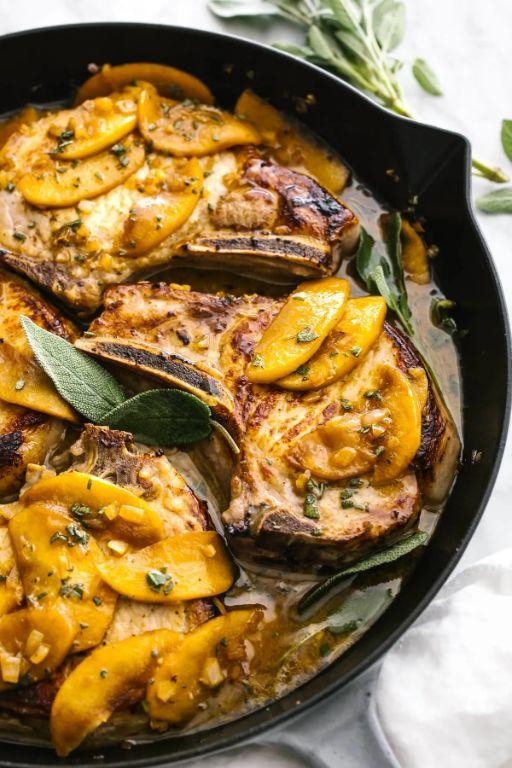
Evenings like this, when the air turns crisp and carries the scent of woodsmoke, I find myself drawn to the kitchen, to the quiet ritual of preparing something that feels like autumn itself. There’s a particular comfort in blending the sweet tang of orchard apples with the earthy wisdom of garden herbs, creating a marinade that transforms simple pork into something memorable. This apple cider and sage combination feels like wrapping yourself in your favorite wool blanket while watching golden leaves drift past the window.
Ingredients
– 1 ½ pounds heritage breed pork tenderloin
– 1 cup unfiltered apple cider
– ¼ cup extra virgin olive oil
– 3 tablespoons pure maple syrup
– 2 tablespoons apple cider vinegar
– 8 fresh sage leaves, finely chiffonaded
– 3 garlic cloves, microplaned
– 1 teaspoon fine sea salt
– ½ teaspoon freshly cracked black pepper
– ¼ teaspoon smoked paprika
Instructions
1. Combine 1 cup unfiltered apple cider, ¼ cup extra virgin olive oil, 3 tablespoons pure maple syrup, 2 tablespoons apple cider vinegar, 8 finely chiffonaded fresh sage leaves, 3 microplaned garlic cloves, 1 teaspoon fine sea salt, ½ teaspoon freshly cracked black pepper, and ¼ teaspoon smoked paprika in a glass mixing bowl.
2. Whisk the marinade ingredients vigorously for 60 seconds until fully emulsified and slightly frothy.
3. Pat 1 ½ pounds heritage breed pork tenderloin completely dry with paper towels to ensure proper marinade adhesion.
4. Place the dried pork tenderloin in a gallon-sized resealable plastic bag and pour the prepared marinade over the meat.
5. Press out all air from the bag before sealing to ensure the pork is fully submerged in the marinade.
6. Refrigerate the marinating pork for exactly 4 hours, turning the bag over once at the 2-hour mark for even flavor distribution.
7. Remove the pork from the refrigerator 30 minutes before cooking to bring it to room temperature for even cooking.
8. Preheat your oven to 400°F and position the rack in the center of the oven.
9. Heat a large oven-safe skillet over medium-high heat for 2 minutes until properly heated.
10. Remove the pork from the marinade, allowing excess liquid to drip off, and reserve the remaining marinade.
11. Sear the pork in the dry, hot skillet for 2 minutes per side until a golden-brown crust forms.
12. Transfer the entire skillet to the preheated oven and roast for 18-20 minutes until the internal temperature reaches 145°F on an instant-read thermometer.
13. While the pork roasts, pour the reserved marinade into a small saucepan and bring to a rolling boil for 3 minutes to eliminate any bacteria.
14. Reduce the heat to medium and simmer the marinade for 8-10 minutes until it reduces to a syrupy glaze.
15. Remove the pork from the oven and transfer to a cutting board, tenting loosely with foil for 8 minutes to allow juices to redistribute.
16. Brush the reduced glaze generously over the rested pork before slicing.
17. Slice the pork against the grain into ½-inch medallions using a sharp carving knife.
Something magical happens when the sweet reduction caramelizes against the perfectly cooked pork, creating a glossy sheen that promises depth in every bite. The tenderloin slices reveal a blush-pink interior that melts against your tongue, while the sage-infused crust provides an earthy counterpoint to the apple’s bright acidity. Serve these medallions over creamy polenta or alongside roasted root vegetables, where the marinade’s reduced glaze can mingle with other autumnal flavors on the plate.
Conclusion
You now have 24 incredible pork steak marinades to transform your meals into tender, flavor-packed experiences. We hope these recipes inspire you to fire up the grill or preheat the oven. Try them out, leave a comment with your favorite, and don’t forget to share this roundup with your fellow food lovers on Pinterest!



